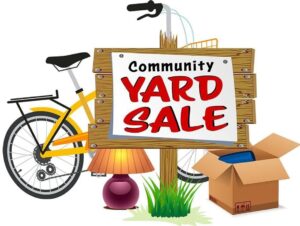 Coming this weekend, March 5th, is the community yard sale at Magnolia Square Park in Blountstown. It will be held from 9am-12pm. Currently, there are 15 people signed up to sell at this event. If you are interested in selling, there are more spots available. Contact Main Street Blountstown, Inc on Facebook or call 850-841-0359.
Coming this weekend, March 5th, is the community yard sale at Magnolia Square Park in Blountstown. It will be held from 9am-12pm. Currently, there are 15 people signed up to sell at this event. If you are interested in selling, there are more spots available. Contact Main Street Blountstown, Inc on Facebook or call 850-841-0359.
Category: Parks (Community/State/National)
News about Torreya State Park
The Florida Department of Environmental Protection (DEP) recently announced that Torreya State Park has been designated a State Geological Site. The agency describes State Geological Sites as “areas the Florida Geological Survey has determined to be significant to scientific study and the public’s understanding of Florida’s geological history.” source This is especially important for Torreya as the park is still in recovery from Hurricane Michael, and State Geological Sites receive more support and interest.
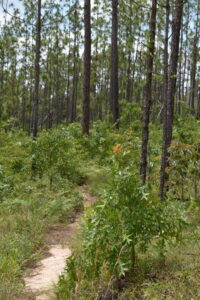
The agency explained that “Torreya State Park was chosen for this designation in part because of the park’s Rock Bluff, a steep, tall, limestone bluff that has been exposed by erosion from the Apalachicola River. Rock Bluff is part of the Torreya Formation and is about 18 million years old. Marine fossils (…) are found in the limestone formations exposed along the Apalachicola River and in the streambeds within the park.”
Mardi Gras Barkus Parade
Tomorrow is the 11th annual Mardi Gras Barkus Parade. This is a special Mardi Gras parade hosted by the Mystic Krewe of Salty Barkers, a Krewe of dogs and their humans.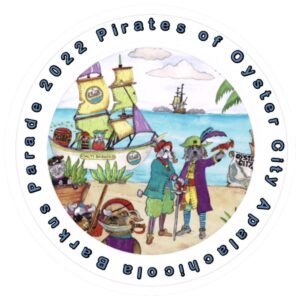
The Krewe is a 501(c)3 non-profit organization and the parade proceeds will go towards the benefit of local animal charities. The theme of this year’s parade is Pirates of Oyster City; the event will include live music, local food and drink, and arts and crafts vendors. Festivities will start at 11am at Riverfront Park. The parade of costumed dogs, people, golf carts, boats, and floats will begin at 1pm. As always, the King and Queen of the Apalachicola Mardi Gras parade are shelter animals who are up for adoption; they have a place of honor in the parade. Learn more at the Mystic Krewe website here.
Bay County Audobon Society: Local Field Trip
Today at 7:30am, there will be a local field trip held at Majette Park by the Bay County Audobon Society. Interested in birding? Native plants? Photography? Just getting out and stretching your legs? This field trip has something for everything!
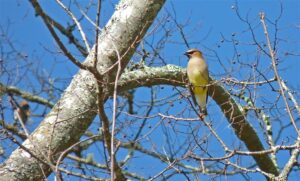
Please note that trips are subject to weather and last-minute changes. Additionally, due to COVID, facemasks are recommended while in close contact but may be removed once members spread out more than 6 feet during the walk. See their Facebook page, electronic newsletter, or Meetup page for up-to-date information; alternatively, call Ron Houser at 850-774-9733.
PCB Conservation Park Birding
 Interested in birding, photography, or learning about the natural world? Consider taking part in one of the upcoming Birding Walks at the Panama City Beach Conservation Park. The walk will be held twice this month on February 12th and again on February 19th from 7:30-9:30 am. The early morning walk will be led by a member of Bay County’s Audubon Society. Participants are not required to have their own binoculars but are encouraged to bring water. For more information, please contact the PCB Parks Department at (850)233-5045.
Interested in birding, photography, or learning about the natural world? Consider taking part in one of the upcoming Birding Walks at the Panama City Beach Conservation Park. The walk will be held twice this month on February 12th and again on February 19th from 7:30-9:30 am. The early morning walk will be led by a member of Bay County’s Audubon Society. Participants are not required to have their own binoculars but are encouraged to bring water. For more information, please contact the PCB Parks Department at (850)233-5045.
Panhandle Flower Spotlight
American beautyberry is a lovely plant that offers two wonderful display times each year. It is also known as French mulberry, sourbush, bunchberry, or purple beauty-berry. In the late spring and early summer, there are light colored lavendar flowers in small clusters along the upright stems of the plant. In fall, there is a big showing of color in the form of shiny purple fruit clusters called drupes.
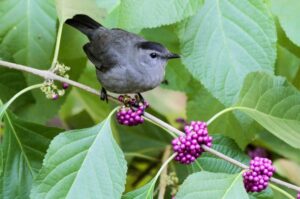
American beautyberry is very important for the local wildlife; cattle enjoy the twigs and leaves in the winter and twigs in the winter. Additionally, the fruit is important for over forty types of songbirds including the American Robin, Brown Thrasher, Purple Finch, and Eastern Towhee. The drupes/clusters are eaten by armadillo, foxes, opossum, raccoon, and squirrels. Additionally, white tailed deer consume the fruit in the fall after leaves drop. They also browse the leaves in summer when highly preferred foods are not available.
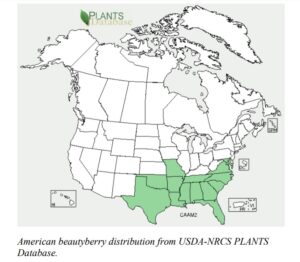 Bunchberry is also used for botanical home remedies. For instance, the roots, leaves, and branches were used by various Native American tribes for medicinal purposes to treat malarial fevers and rheumatism. The roots were used to treat dizziness, stomachaches and dysentery. Roots and berries were boiled and drunk to treat colic. The leaves can be crushed and stuffed in pockets or under hats to repel mosquitoes. Studies conducted by the Agricultural Research Service has shown two compounds – callicarpenal and intermedeol – are responsible for the repellant effect.
Bunchberry is also used for botanical home remedies. For instance, the roots, leaves, and branches were used by various Native American tribes for medicinal purposes to treat malarial fevers and rheumatism. The roots were used to treat dizziness, stomachaches and dysentery. Roots and berries were boiled and drunk to treat colic. The leaves can be crushed and stuffed in pockets or under hats to repel mosquitoes. Studies conducted by the Agricultural Research Service has shown two compounds – callicarpenal and intermedeol – are responsible for the repellant effect.
Panhandle Flower Spotlight
 False Foxglove is named for the appearance of their brilliant pink flowers which bear a resemblance to the northern favorite Foxglove. False Foxglove actually covers a collection of closely related parasitic plants that are difficult to distinguish by all but the keenest of botanists. False Foxglove is an unusual and important Florida native plant that explodes into beautiful, vibrantly colored flowers of light purple to pink from September to December.
False Foxglove is named for the appearance of their brilliant pink flowers which bear a resemblance to the northern favorite Foxglove. False Foxglove actually covers a collection of closely related parasitic plants that are difficult to distinguish by all but the keenest of botanists. False Foxglove is an unusual and important Florida native plant that explodes into beautiful, vibrantly colored flowers of light purple to pink from September to December.
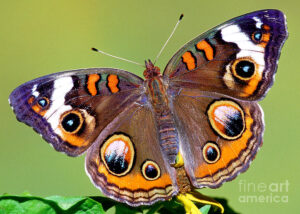
This species plays important ecological roles in Florida’s natural areas. The tubular flowers are the preferred nectar source for the larger-sized native solitary and bumble bees present in the Panhandle, although all manner of bees and butterflies will also visit. Additionally, False Foxglove is the primary host plant for the unique Common Buckeye butterfly. Common Buckeye larvae (caterpillars) feed on False Foxglove foliage during the summer before emerging as adults.
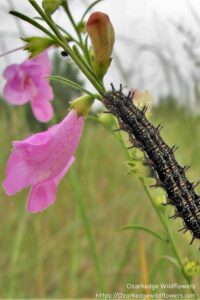 False Foxglove is an important indicator of a healthy native ecosystem. As a parasitic plant, False Foxglove obtains nutrients and energy by photosynthesis AND by using specialized roots to tap into the roots of nearby suitable hosts (native grasses and other plants). As both False Foxglove and its parasitic host plants prefer to grow in the sunny, fire-exposed pine flatwoods and sand ridges that characterized the natural pre-settlement Florida, an area with an abundance of False Foxglove in flower is likely in good ecological shape! A perfect example of this is Torreya State Park, an area that explodes in beautiful fall foliage around September.
False Foxglove is an important indicator of a healthy native ecosystem. As a parasitic plant, False Foxglove obtains nutrients and energy by photosynthesis AND by using specialized roots to tap into the roots of nearby suitable hosts (native grasses and other plants). As both False Foxglove and its parasitic host plants prefer to grow in the sunny, fire-exposed pine flatwoods and sand ridges that characterized the natural pre-settlement Florida, an area with an abundance of False Foxglove in flower is likely in good ecological shape! A perfect example of this is Torreya State Park, an area that explodes in beautiful fall foliage around September.
Night of Lights Sail
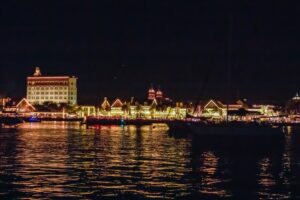 Take a fun day-trip to St. Augustine this Sunday for a special event held by St. Augustine Sailing. The Hop On, Hop Off: Night of Lights Sail is a one night only event that allows guests to enjoy one-hour cruises along St. Augustine’s bayfront in a luxury yacht.
Take a fun day-trip to St. Augustine this Sunday for a special event held by St. Augustine Sailing. The Hop On, Hop Off: Night of Lights Sail is a one night only event that allows guests to enjoy one-hour cruises along St. Augustine’s bayfront in a luxury yacht.
Guests will be able to reserve spots on the yachts; they will leave every 15mins starts at 4:45pm. Each cruise includes a spectacular view of the city’s millions of lights, a waterfront BBQ feast, and live entertainment from local muisician Rob Peck. The BBQ feast will be held at the Camachee Cove Marina Patio Deck. Come enjoy the last weekend of the Night of Lights spectacular with this special cruise event! Tickets range from $69.00 for children under 5 to $149.00 for adults. For tickets, go here.
Butts & Clucks Cook-Off
 The 2022 Butts & Clucks Cook-off on the Bay, sanctioned by the Florida BBQ Association, will be held today and tomorrow. The event will be held in Battery Park in Apalachicola. With over $12,000 in prizes to be awarded and delicious food to be enjoyed, this two-day event is sure to make a fun weekend. There will be a Shut up and Shuck party, judges, and a Deviled Egg contest on Saturday the 22nd. Visit the official event webpage to learn more.
The 2022 Butts & Clucks Cook-off on the Bay, sanctioned by the Florida BBQ Association, will be held today and tomorrow. The event will be held in Battery Park in Apalachicola. With over $12,000 in prizes to be awarded and delicious food to be enjoyed, this two-day event is sure to make a fun weekend. There will be a Shut up and Shuck party, judges, and a Deviled Egg contest on Saturday the 22nd. Visit the official event webpage to learn more.
Native Wildflowers of Florida

The Florida Wildflower Foundation defines “Florida native wildflowers” as any flowering herbaceous species that grew wild within the state’s natural ecosystems in the 1560s; this is when Florida’s first botanical records were created. The defenition also recognizes natives as flowering plants and grasses introduced before that time by Native Americans through travel and trade, as well as wildflowers introduced without aid of human intervention. Native wildflowers are crucial for the health of the variety of ecosystems found in Florida; if you want to see a plethora of wildlife and beautiful blooms, plant native! Spring and fall are the time for showy fields of wildflowers but Florida also boosts beautiful summer blooms such as meadowbeauty and hibiscus.
Please don’t pick wildflowers! Preserve your memories with a picture, art, or the written word – it will last much longer. Picking flowers reduces a plants’ ability to sustain itself and grow back stronger the next season. Additionally, picking the flowers of endangered or threatened species is illegal (see Florida Statute 581.185 Preservation of native flora of Florida). Want to spread the natural beauty of the Sunshine State? Send your photos to photos@flawildflowers.org.